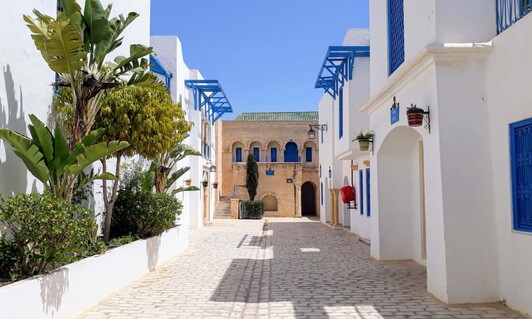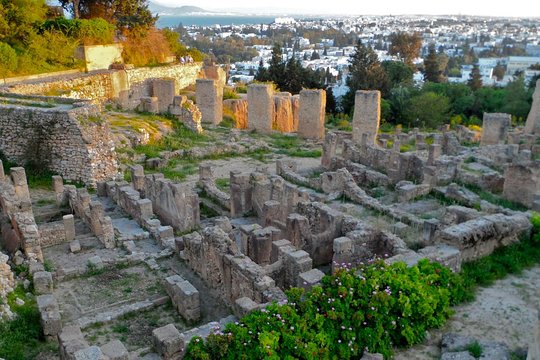Healing the Past - A Retreat to Tunisia
15-22 Feb 2020
When there is grief, pain or saddness in our past, we might be experiencing it in the present without knowing why. The past cannot be changed, but the way we look at it in the present can. This retreat is about healing our relationship with our past so that we can look back at our experiences with a sense of perspective, peace and healing.
What better way to heal the past, than to step into it? Tunisia is a magical place where time seems to have been stopped. Immersed in the experience of friendly locals, divine cuisine, lush textiles, aromatic spices, historic sites and inviting nature, we take ourselves back in time so that we can live our present more fully.
In our retreat we will not be only taking all those journeys on the outside, we will also be taking them on the inside through Yoga, breathing, meditating and introspective reflection. The purpose of the retreat is to make the most of things that had happened in the past, no matter how painful they are, so that we are equipped to heal and move on.
What better way to heal the past, than to step into it? Tunisia is a magical place where time seems to have been stopped. Immersed in the experience of friendly locals, divine cuisine, lush textiles, aromatic spices, historic sites and inviting nature, we take ourselves back in time so that we can live our present more fully.
In our retreat we will not be only taking all those journeys on the outside, we will also be taking them on the inside through Yoga, breathing, meditating and introspective reflection. The purpose of the retreat is to make the most of things that had happened in the past, no matter how painful they are, so that we are equipped to heal and move on.

Location
We will be staying at a traditional Tunisian home botique hotel run by locals in Tunis (details TBA)
Dates
15 to 22 Feb 2019
Recommended Flights
Outbound
Sat 15 Feb Turkish Airlines
1:55am Bahrain (BAH) arriving to Tunis (TUN) 10:15am
Inbound
Sat 22 Feb Turkish Airlines
11:10am Tunis (TUN) arriving to Bahrain Intl. (BAH) 12:55am
Price
BD450 per person (shared room)
Upgrade to private room available subject to availability for additional fee of BD150
To book
Please call 17591565 or email [email protected]
We will be staying at a traditional Tunisian home botique hotel run by locals in Tunis (details TBA)
Dates
15 to 22 Feb 2019
Recommended Flights
Outbound
Sat 15 Feb Turkish Airlines
1:55am Bahrain (BAH) arriving to Tunis (TUN) 10:15am
Inbound
Sat 22 Feb Turkish Airlines
11:10am Tunis (TUN) arriving to Bahrain Intl. (BAH) 12:55am
Price
BD450 per person (shared room)
Upgrade to private room available subject to availability for additional fee of BD150
To book
Please call 17591565 or email [email protected]

What your package includes*
- Daily morning practice of breathing, meditation and Asana (2.5 hour practice)
- Fresh breakfast daily
- Your accommodation
- Afternoon reflection sessions or restorative evening practice
- Your transport to and from the airport
- Your transport to all the sites as described in the itinerary below
The Itinerary**
15 Feb
Arrival at the hotel from 11am onwards
Leisure time and walk/lunch
5pm opening circle and setting intention
6pm restorative Yoga
16 Feb
7am Yoga
8:30 Breathing and Meditation
9:30 Breakfast
11:30 Carthage, UNESCO World Heritage site, Antonine Baths, halk elwed and Sidi Bou Saïd. Sea view dinner at Marabou City
11:30 am
6pm Lecture
17 Feb
7am Yoga
8:30 Breathing and Meditation
9:30 Breakfast
11:30am Bardo Museum, leave to Medina, a local market where you shop & see souq de chechias where traditional blood-red felt caps are made. Free time for shopping and crossing Habib Bourguiba Avenue "main artery of Tunis"
8pm Yoga Nidra
18 Feb
7am Yoga
8:30 Breathing and Meditation
9:30 Breakfast
5pm Lecture
19 Feb
7am Yoga
8:30 Breathing and Meditation
9:30 Breakfast
11:30am Departure to Nabeul. Visit a specialty pottery workshop in the area the roam around the city to discover the market, medina and souk. Hammamet to immerse in Ottoman and the Andalusian architecture
8pm Meditation
20 Feb
7am Yoga
8:30 Breathing and Meditation
9:30 Breakfast
5pm Lecture
21 Feb
7am Yoga
8:30 Breathing and Meditation
9:30 Breakfast
11:30am Sousse and port Kantaoui and Monastir this modern tourist resort is provided with luxurious hotel complexes, which are located all along the Dkhila coast and divided up in the city. Visit of Port El Kantaoui , a watering place located on a panoramic coastal strip : its arcades, paved alleys flowery places and restaurant on the sea-front give the site a charm of the past. Visit of the new sailing harbour: Cap Monastir. a superb modern marina of which the yacht harbour is of fair size accommodating about three hundred boats. Head to Ribat then the Bourguiba’s Mausoleum.
7pm Closing circle
22 Feb
Goodbyes (checkout by 12pm)
15 Feb
Arrival at the hotel from 11am onwards
Leisure time and walk/lunch
5pm opening circle and setting intention
6pm restorative Yoga
16 Feb
7am Yoga
8:30 Breathing and Meditation
9:30 Breakfast
11:30 Carthage, UNESCO World Heritage site, Antonine Baths, halk elwed and Sidi Bou Saïd. Sea view dinner at Marabou City
11:30 am
6pm Lecture
17 Feb
7am Yoga
8:30 Breathing and Meditation
9:30 Breakfast
11:30am Bardo Museum, leave to Medina, a local market where you shop & see souq de chechias where traditional blood-red felt caps are made. Free time for shopping and crossing Habib Bourguiba Avenue "main artery of Tunis"
8pm Yoga Nidra
18 Feb
7am Yoga
8:30 Breathing and Meditation
9:30 Breakfast
5pm Lecture
19 Feb
7am Yoga
8:30 Breathing and Meditation
9:30 Breakfast
11:30am Departure to Nabeul. Visit a specialty pottery workshop in the area the roam around the city to discover the market, medina and souk. Hammamet to immerse in Ottoman and the Andalusian architecture
8pm Meditation
20 Feb
7am Yoga
8:30 Breathing and Meditation
9:30 Breakfast
5pm Lecture
21 Feb
7am Yoga
8:30 Breathing and Meditation
9:30 Breakfast
11:30am Sousse and port Kantaoui and Monastir this modern tourist resort is provided with luxurious hotel complexes, which are located all along the Dkhila coast and divided up in the city. Visit of Port El Kantaoui , a watering place located on a panoramic coastal strip : its arcades, paved alleys flowery places and restaurant on the sea-front give the site a charm of the past. Visit of the new sailing harbour: Cap Monastir. a superb modern marina of which the yacht harbour is of fair size accommodating about three hundred boats. Head to Ribat then the Bourguiba’s Mausoleum.
7pm Closing circle
22 Feb
Goodbyes (checkout by 12pm)
About the sites
Bardo Museum
The main draw at the Tunisia's top museum is its magnificent collection of Roman mosaics. These provide a vibrant and fascinating portrait of ancient North African life. Also here is some equally magnificent Hellenistic and Punic statuary. The massive collection is housed in an imposing palace complex built under the Hafsids (1228–1574), and fortified and extended by the Ottomans in the 18th century. The original palace buildings now connect with a dramatic contemporary annexe, which has doubled the exhibition space.
Read More
Carthage
Carthage is Tunis’ most exclusive residential suburb and retains a sense of historical importance forged over millennia – as well as being home to the Unesco-listed Carthage Archaeological Park, it's the location of both the president’s palace and the massive Mosque Malik Ibn Anas Carthage on Boulevard de l'Environnement.
Read More
Hammamet
Stretched out across Cap Bon's southeastern coast like a lazy sunbather, laid-back Hammamet (‘the baths’ in Arabic) is Tunisia's original resort town. Early planning constraints dictated that hotels should not overreach the height of a tree, meaning that Hammamet's buildings sprawl horizontally, a far cry from the brutal high-rise developments that have scarred so many other Mediterranean coasts.
READ MORE
Medina
This sprawling maze of ancient streets and alleyways is one of the most impressive medieval medinas in North Africa and one of Tunisia's great treasures. It's home to numerous covered souqs selling everything from shoes to shisha pipes, as well as bustling cafes, back streets full of artisans at work and residential areas punctuated by grand, brightly painted doorways. Historic palaces, hammams, mosques and madrassas (schools for study of the Quran) are scattered throughout, many lavishly decorated with tiles, carved stucco and marble columns.
Read More
Sidi Bou Saïd
With its distinctive blue-and-white colour scheme, cobbled streets and jaw-dropping glimpses of azure waters, the cliff-top village of Sidi Bou Saïd is one of the prettiest spots in Tunisia. Named after a 13th-century Sufi saint, its distinctive architecture is a mix of the Ottoman and the Andalusian, a result of the influx of Spanish Muslims in the 16th century. For the French, the sleepy fishing village was a perfect depiction of the Orientalism romanticised by Europeans in the 19th century, and they committed to ensuring that its character – both real and imagined – was preserved (it was given protected status in 1915). Past residents and visitors include artist Paul Klee, author André Gide, philosopher Michel Foucault, and arty British eccentrics Osbert and Edith Sitwell. It still retains a sense of North African fantasia today, both for visitors and interestingly enough, for Tunisians themselves.
Read More
*Please note that your package does not include Air Fares, meals other than breakfast, tickets/tour guides required during tours
** The itinerary is subject to small changes based on the groups' needs
** The itinerary is subject to small changes based on the groups' needs
Proudly powered by Weebly


